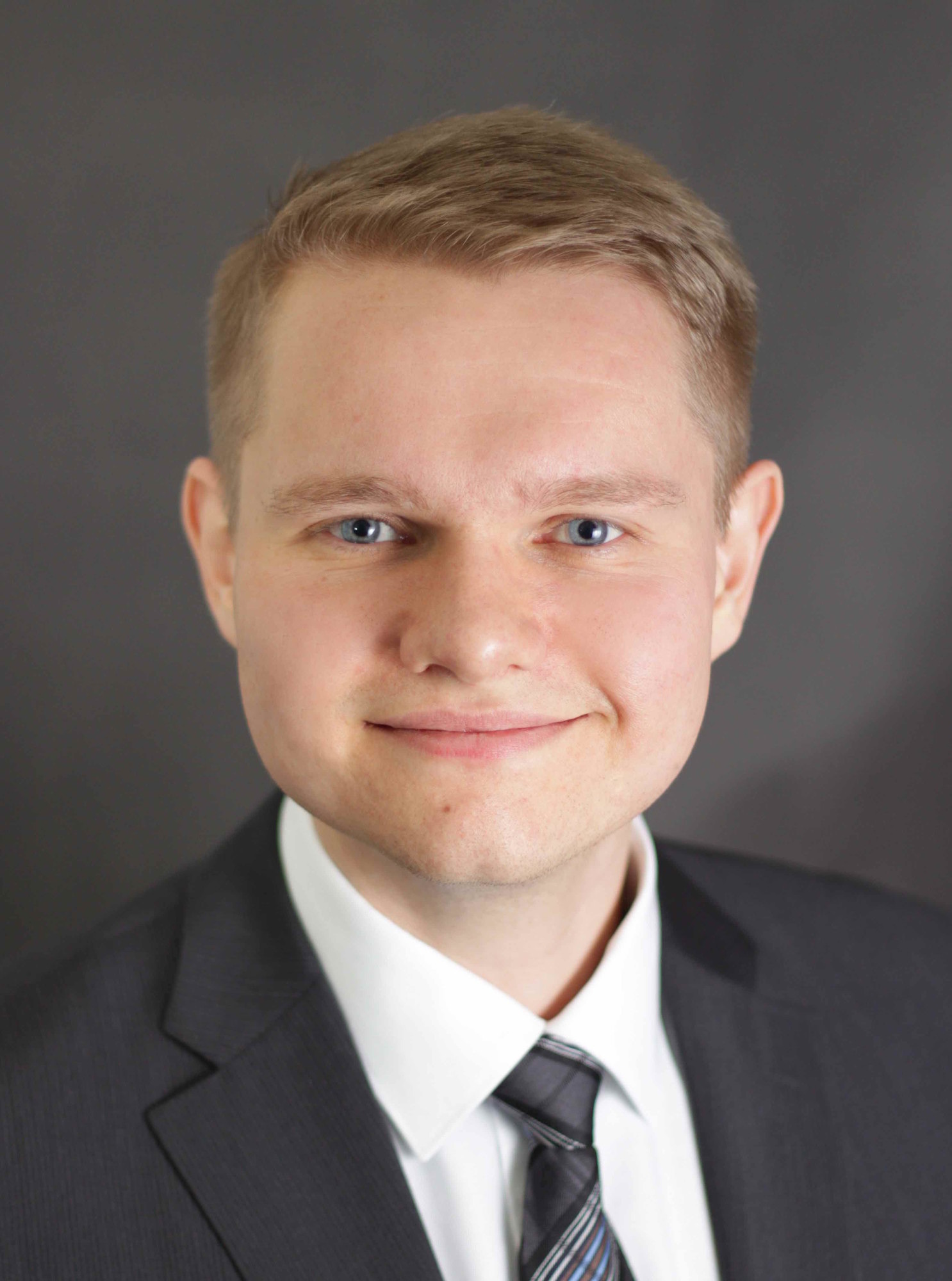Johann Penner
Johann Penner
2011 – 2014 B.Sc., Bachelor in Mechanical Engineering, Friedrich-Alexander-Universität Erlangen-Nürnberg
2014 – 2016 M.Sc., Master in Mechanical Engineering, Friedrich-Alexander-Universität Erlangen-Nürnberg
2016 – 2021 Doctoral candidate, Institute of Applied Dynamics, Friedrich-Alexander-Universität Erlangen-Nürnberg
theses
2023
- :
A discrete variational approach to muscle wrapping in musculoskeletal optimal control simulations (Dissertation, 2023)
2016
- :
Modellbildung und Optimalsteuerung einer spurgebundenen Modellrennbahn (Master thesis, 2016)
2015
- :
Charakterisierung von Reibmodellen zur Simulation eines inversen Pendels. (Other / na, 2015)
2014
- :
FE-Simulation geschichteter Strukturen unter Berücksichtigung des Kontaktverhaltens. (Bachelor thesis, 2014)
reviewed journal publications
2025
- , , , , , , , , , , , , , :
Sensor-assessed grasping time as a biomarker of functional impairment in rheumatoid arthritis
In: Scientific Reports 15 (2025), Article No.: 6018
ISSN: 2045-2322
DOI: 10.1038/s41598-025-90295-7
2022
- , :
A discrete mechanics approach for musculoskeletal simulations with muscle wrapping
In: Multibody System Dynamics (2022)
ISSN: 1384-5640
DOI: 10.1007/s11044-022-09844-x
2021
- , , , , , , , , :
Evaluation of Optical and Radar Based Motion Capturing Technologies for Characterizing Hand Movement in Rheumatoid Arthritis — A Pilot Study
In: Sensors 21 (2021), Article No.: 1208
ISSN: 1424-8220
DOI: 10.3390/s21041208
conferences and proceedings
2022
- , , , , , , , , , , , , , , :
Feasibility of using optoelectronic measurement of hand movement for characterizing hand function in rheumatoid arthritis
75th EULAR (European Alliance of Associations for Rheumatology), European Congress of Rheumatology 2022 (Copenhagen, 2022-06-01 - 2022-06-04)
DOI: 10.1136/annrheumdis-2022-eular.1741 - , , , , , , , , , , , , , , :
Evaluation of marker-based motion capturing to charactherize basic hand movements in rheumatic patients
27th Congress of the European Society of Biomechanics (Porto, 2022-06-26 - 2022-06-29) - , , , , , , , , , , , , , , :
Establishment and evaluation of a sensor-based method to assess hand function in patients with rheumatoid arthritis
conference, World Biomechanics Congress 2022 (Taipei (online), 2022-07-10 - 2022-07-14) - , , , , , :
Comparison of different approaches for the personalization of a kinematic hand model
conference, World Biomechanics Congress 2022 (Taipei (Online), 2022-07-10 - 2022-07-14)
URL: https://www.wcb2022.com
2021
- , , :
Geometric numerical integration in simulation and optimal control of biomechanical motion
Invited lecture, GAMM Annual Meeting (Kassel, 2021-03-15 - 2021-03-19)
2020
- , :
Defining Kinematic Chains for Musculoskeletal Optimal Control Simulations via Automatic Differentiation
6th International Digital Human Modeling Symposium (Skövde, 2020-08-31 - 2020-09-02)
In: Proceedings of the 6th International Digital Human Modeling Symposium 2020
Open Access: http://ebooks.iospress.nl/volume/dhm2020-proceedings-of-the-6th-international-digital-human-modeling-symposium
2019
- , :
A Hill Muscle Actuated Arm Model with Dynamic Muscle Paths
ECCOMAS Thematic Conference on Mutlibody Dynamics (Duisburg)
In: Proceedings of the ECCOMAS Thematic Conference on Mutlibody Dynamics 2019
DOI: 10.1007/978-3-030-23132-3_7 - , :
Biomechanical simulations with dynamic muscle paths on NURBS surfaces
GAMM Annual Meeting (Vienna, 2019-02-18 - 2019-02-22)
In: Proc. Appl. Math. Mech (PAMM) 2019
DOI: 10.1002/pamm.201900230
2018
- , :
Multi-Obstacle Muscle Wrapping Based on a Discrete Variational Principle
Progress in Industrial Mathematics at ECMI 2018
In: Progress in Industrial Mathematics at ECMI 2018 2018
DOI: 10.1007/978-3-030-27550-1_28 - , :
Optimization based muscle wrapping in biomechanical multibody simulations
GAMM Annual Meeting (Munich, 2018-03-19 - 2018-03-23)
In: Proc. Appl. Math. Mech (PAMM) 2018
DOI: 10.1002/pamm.201800311
2017
- , , :
Optimal control of a slot car racer
GAMM Annual Meeting (Weimar, 2017-03-06 - 2017-03-10)
In: Proc. Appl. Math. Mech (PAMM) 2017
DOI: 10.1002/pamm.201710238 - , , :
Optimal control of a slot car racer
The 7th GACM Colloquium on Computational Mechanics (Stuttgart, 2017-10-11 - 2017-10-13)
In: Proceedings of the 7th GACM 2017
further publications
-
Muscle paths in the biomechanical simulation of human movement and MBS integration
(Third Party Funds Group – Sub project)
Overall project: 05M2016 - DYMARA: A dynamic manikin with fibre-based modelling of skeletal musculature
Term: 2016-12-01 - 2020-06-30
Funding source: BMBF / VerbundprojektDas Verbundprojekt DYMARA hat die Entwicklung eines innovativen digitalen Menschmodells (Manikins) mit detaillierter Modellierung der Skelettmuskulatur und schnellen numerischen Algorithmen zum Ziel. Mit diesem Manikin soll es möglich werden, den Menschen simulationsgestützt auf optimale Weise in sein Arbeitsumfeld zu integrieren und Ermüdungen, Erkrankungen sowie Unfälle am Arbeitsplatz zu vermeiden. Neben diesen ergonomischen Gesichtspunkten soll das Menschmodell auch zur Therapieplanung im muskulären Bereich und zur Gestaltung von Prothesen und Orthesen eingesetzt werden können. Um die Dynamik des muskuloskeletalen Systems hinreichend genau zu erfassen, wird ein Modellierungsansatz verfolgt, der auf der Methode der mechanischen Mehrkörpersysteme (MKS) basiert. Solche Modelle sind durch die Robotik inspiriert und werden bereits heute in vielen biomechanischen Anwendungsfeldern eingesetzt. Die Modellierung der Muskulatur stellt jedoch nach wie vor eine große Herausforderung dar, insbesondere wenn Aspekte wie Rechenzeit auf der einen und Berücksichtigung der anatomischen und physiologischen Gegebenheiten auf der anderen Seite zu beachten sind. Hier setzen wir mit unserem Projekt an: Ein neu zu entwickelndes eindimensionales Kontinuumsmodell, das einzelne Muskelfaserbündel realitätsnah beschreibt, soll die bisher üblichen diskreten Kraftelemente im MKS-Modell ersetzen und mit schnellen, problemangepassten numerischen Algorithmen zur Berechnung von Bewegungssequenzen und zur Steuerung des Manikins kombiniert werden.

